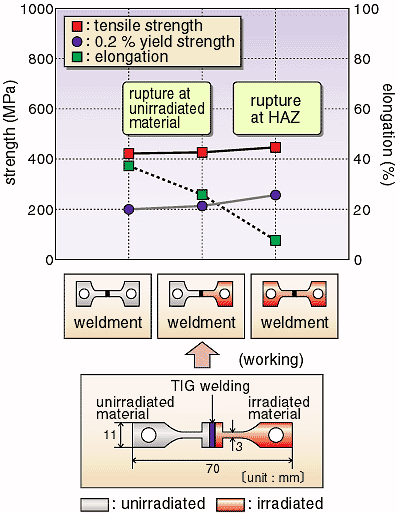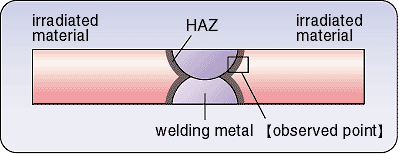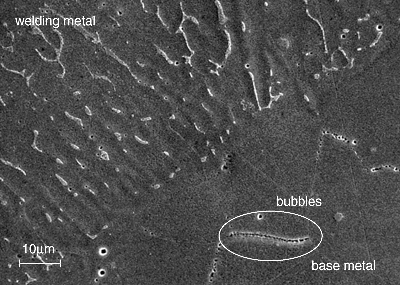 |
|||||
|
|||||
  |
|||||
|
|||||
| For the repair or exchange of in-vessel components, vacuum vessel,
etc. of a fusion reactor, rewelding is necessary after cutting
part of the equipment. But it is not clear whether the welded part will be able to retain the same strength as the original equipment after rewelding, because the used materials have been irradiated by high energy (fast) neutrons arising from fusion reactions. So, for the evaluation of the effect on mechanical properties with rewelding, type 316 stainless steel (SS316) specimens were irradiated in JMTR by a fast neutron fluence of 2.0*1020 n/cm2, and/or unirradiated SS316 specimens were rewelded by the tungsten inert gas (TIG) welding method, and then tensile tests were carried out on three combinations of weldments. As a result, although the tensile strength and 0.2% yield strength were almost similar on every combination, as shown in Fig. 8-5, the apparent elongation decreased in the order described the following: unirrad./unirrad. > unirrad./irrad. > irrad./irrad. (unirrad. : unirradiated SS316, irrad. : irradiated SS316) Particularly, specimen of irradiated /irradiated SS316 was elongated little and broken at the part affected by the welding heat (heat-affected zone: HAZ). A SEM (scanning electron microscope) micrograph of the weldment cross section of irradiated/irradiated SS316 is shown in Fig. 8-6. Small bubbles were observed along the grain boundary in the HAZ. It is supposed that helium voids generated by neutron irradiation defuse and condense along the grain boundary in the HAZ. A coalescence of these bubbles disintegrates mechanical strength of welded specimen. From these results, the relation between mechanical properties and rewelding of unirradiated and/or irradiated SS316, a repair qualification is satisfied by using at least one new subcomponent after cutting the equipment. |
| Reference K. Tsuchiya et al., Reweldability Test of Irradiated SS316 by TIG Welding Method, J. Nucl. Mater., 233, 218 (1996). |
| Select a topic in left column |
|
Persistent Quest-Research Activities 1998 Copyright(c)Japan Atomic Energy Research Institute |